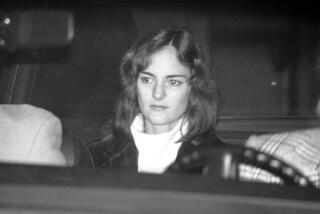Even in Death, O’Hair Is in Middle of Battle as Atheists Seek Her Ashes
- Share via
HOUSTON — Even now, her body burned to ash and smothered with dirt in an unmarked grave, Madalyn Murray O’Hair remains the stuff of bilious battle.
Quietly, privately, O’Hair was laid into an anonymous cemetery vault in the Texas hills last week. Her estranged Baptist son buried his slain mother, daughter and brother--three generations of atheists tucked away side by side. When the vault was covered and the improbable prayers spoken, it looked like the end of a bitter and bloody saga.
But it wasn’t. The American Atheists, the group founded by O’Hair three decades back that succeeded in driving prayer from the public schools, says William J. Murray had no right to bury his mother.
O’Hair left everything to the organization’s New Jersey library, President Ellen Johnson says. Murray was disinherited, she says, and shouldn’t have been able to claim his mother’s bones.
“He had no right to those remains; he had no right to any of her things,” Johnson said. “Hopefully, we’ll still get those remains back.”
It’s an unlikely battle for an anti-religious group, a struggle for her ashes that threatens to transform O’Hair into a sort of atheist saint.
“The atheists see those remains as a mechanism to reaffirm the community,” said Gary Laderman, religion professor at Emory University and author of a book on American attitudes toward death.
“Even though they wouldn’t agree with me, I think this kind of interest in the remains is clearly a religious activity.”
The veneration of human remains has long been entwined with religion. Some historians mark the moment when ancient man began to rub dead bodies with red ochre, curl them into the fetal position and bury them in the dirt as the evolutionary beginning of religious consciousness.
Europe is littered with yellowed bones and frayed cotton scraps reportedly left by Catholic saints. Tibetan monks sometimes meditate beside decomposing bodies.
O’Hair hated the idea of burial, says Ron Houdyshell, a lawyer for the American Atheists. It smacked of ritual and ceremony. She wanted to be cremated, her ashes scattered.
Houdyshell called the burial “very strange and very spiteful.”
The American Atheists are bent on carrying out the wishes of their tough-talking founding mother. Determined to ferret out the unmarked burial site, the group may sue to have the remains handed over, Houdyshell said.
In theory, Texas law entitles Murray to bury his mother, but the American Atheists believe O’Hair’s will proves the organization has a right to her remains.
“It speaks to an attempt to maintain a sense of collective identity,” Laderman says. “If they can get control of her physical remains, they can shape how she will be remembered.”
The last time anybody saw her alive, O’Hair was 76. She’d spent the early 1990s living in a squat, brick house in Austin, Texas, with son Jon Garth Murray and William Murray’s daughter, Robin Murray O’Hair. It was a quiet, if somewhat litigious, existence: They cooked, gardened and waged a daily paper battle to bleach religion from American thought.
But in 1995, when Robin was 30 and Jon was 40, the family vanished, along with a bundle of gold coins. Tales of conspiracy flew: The three had escaped to New Zealand; they’d stolen from the atheists; they’d been killed.
After six years of speculation, O’Hair’s former office manager admitted kidnapping and killing the three in a plot to steal $600,000 worth of gold. In January, 53-year-old David Roland Waters led investigators to a shallow grave in the ranchland outside San Antonio.
Waters is to be sentenced Friday on a federal conspiracy charge. An accomplice, Gary Paul Karr, is already serving a life term. By the time the bodies were hauled to the surface, there was nothing left but bones and hair. The family was identified by dental records.
O’Hair’s bones made their way through forensic laboratories, through the hands of federal agents and into the care of a funeral home in Austin. Just as the atheists’ remains were being consumed by the fires of cremation, William Murray’s plane nosed onto Texas soil. He was back to bury the nearest kin he had.
Murray’s relationship with his atheist family collapsed decades ago, when he found Jesus and renounced his upbringing.
It was a young William Murray who prodded his mother to file the lawsuit that would prompt the U.S. Supreme Court to kick prayer and Bible study out of public schools. To American Atheists, his fall into organized religion was a kick in the face.
A self-described advocate for “family-friendly legislation,” Murray now lives in Washington, D.C., and writes books, such as “Let Us Pray: A Plea for Prayer in Our Schools,” “My Life Without God” and “The Church Is Not for Perfect People.”
“It is with great trepidation that I write at all about the burial,” he said in a written statement to reporters this week confirming that he had secretly buried his mother. “[They] lived together in a godless state of atheism for decades.”
But when the time came, Murray saw his family buried.
A Baptist pastor stood watch at the burial. Murray insists he didn’t pray over his mother. Evangelical Baptists don’t pray for the dead, he explained.
“The deceased person is in glory with God, or in hell,” he said. “Either way, prayer is fruitless.”
When the dirt was placed over the remains, the cluster of law enforcement officers invited to the burial stepped aside to pray for surviving family members and traumatized investigators, Murray said. Then it was over, and everybody went home.
In the end, the second grave wasn’t much different from the one chosen by the killers: Both were shared; the location of each was a tightly guarded secret. And neither one, atheists say, was what O’Hair would have wanted.
But as for Murray, he’s holding out hope. Maybe, he wrote, before it was too late, his mother had an epiphany.
“That last day they were bound and gagged with duct tape, unable to speak, able only to think,” he said. “In those hours or even days before, did they have a change of heart and turn to Jesus?
“Only when we reach glory will we know.”
More to Read
Sign up for Essential California
The most important California stories and recommendations in your inbox every morning.
You may occasionally receive promotional content from the Los Angeles Times.










